display Peugeot 508 RXH 2014 Owner's Guide
[x] Cancel search | Manufacturer: PEUGEOT, Model Year: 2014, Model line: 508 RXH, Model: Peugeot 508 RXH 2014Pages: 338, PDF Size: 10.81 MB
Page 111 of 338
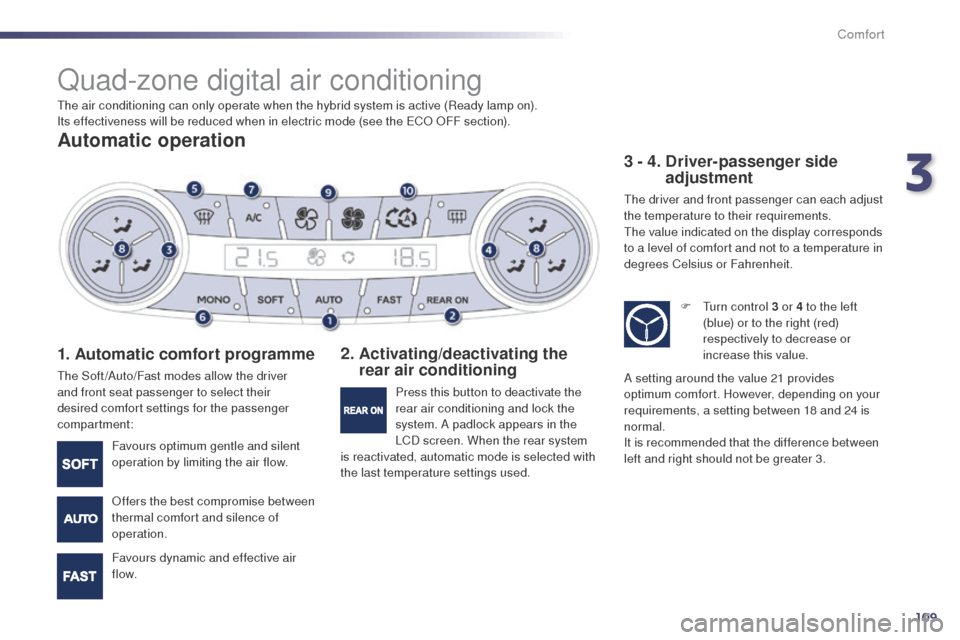
109
508RXH_en_Chap03_confort_ed01-2014
Quad-zone digital air conditioning
Automatic operation
1. Automatic comfort programme
the Soft /Auto/Fast modes allow the driver
and front seat passenger to select their
desired comfort settings for the passenger
compartment:
2. Activating/deactivating the rear air conditioning 3 - 4.
D
river-passenger side
adjustment
the driver and front passenger can each adjust
the temperature to their requirements.
th
e value indicated on the display corresponds
to a level of comfort and not to a temperature in
degrees Celsius or Fahrenheit.
Favours optimum gentle and silent
operation by limiting the air flow.
Offers the best compromise between
thermal comfort and silence of
operation.
Favours dynamic and effective air
f low. Press this button to deactivate the
rear air conditioning and lock the
system. A padlock appears in the
LCD screen. When the rear system
is reactivated, automatic mode is selected with
the last temperature settings used. F
t
u
rn control 3 or 4 to the left
(blue) or to the right (red)
respectively to decrease or
increase this value.
A setting around the value 21 provides
optimum comfort. However, depending on your
requirements, a setting between 18 and 24 is
normal.
It is recommended that the difference between
left and right should not be greater 3.
th
e air conditioning can only operate when the hybrid system is active (Ready lamp on).
Its effectiveness will be reduced when in electric mode (see the
e
C
O OFF section).
3
Comfort
Page 112 of 338
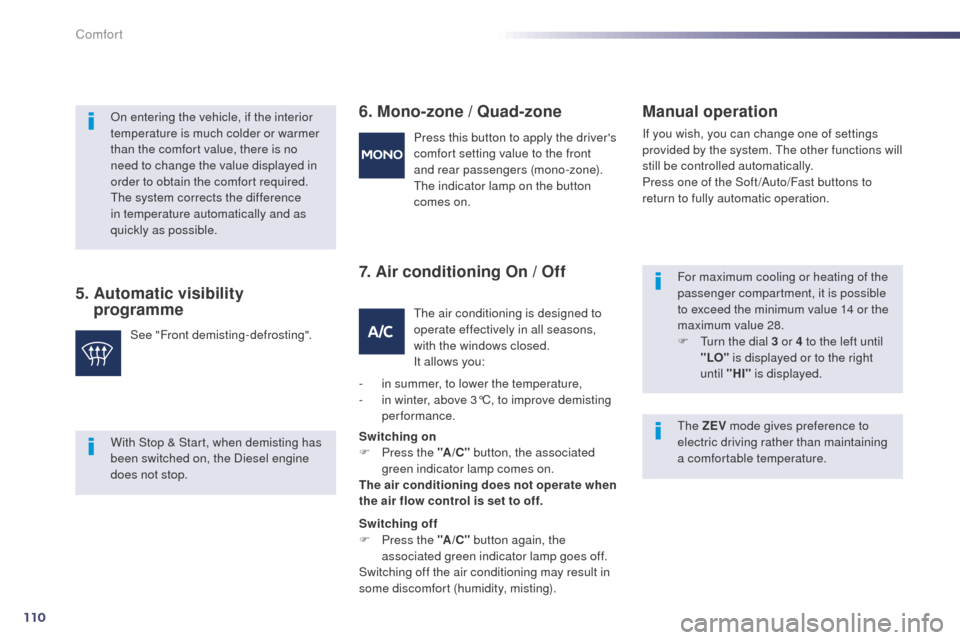
110
508RXH_en_Chap03_confort_ed01-2014
5. Automatic visibility programme 6. Mono-zone
/ Quad-zone
7. Air conditioning On / OffManual operation
If you wish, you can change one of settings
provided by the system.
th e other functions will
still be controlled automatically.
Press one of the Soft /Auto/Fast buttons to
return to fully automatic operation.
On entering the vehicle, if the interior
temperature is much colder or warmer
than the comfort value, there is no
need to change the value displayed in
order to obtain the comfort required.
th
e system corrects the difference
in temperature automatically and as
quickly as possible.
See "Front demisting-defrosting". Press this button to apply the driver's
comfort setting value to the front
and rear passengers (mono-zone).
th
e indicator lamp on the button
comes
on.
th
e air conditioning is designed to
operate effectively in all seasons,
with the windows closed.
It allows you:
-
i
n summer, to lower the temperature,
-
i
n winter, above 3°C, to improve demisting
performance.
Switching on
F
P
ress the "A /C " button, the associated
green indicator lamp comes on.
The air conditioning does not operate when
the air flow control is set to off.
Switching off
F
P
ress the "A /C " button again, the
associated green indicator lamp goes off.
Switching off the air conditioning may result in
some discomfort (humidity, misting). For maximum cooling or heating of the
passenger compartment, it is possible
to exceed the minimum value 14 or the
maximum value 28.
F
t
u
rn the dial 3 or 4 to the left until
"LO" is displayed or to the right
until "HI" is displayed.
With Stop & Start, when demisting has
been switched on, the Diesel engine
does not stop.
th
e ZEV mode gives preference to
electric driving rather than maintaining
a comfortable temperature.
Comfort
Page 119 of 338
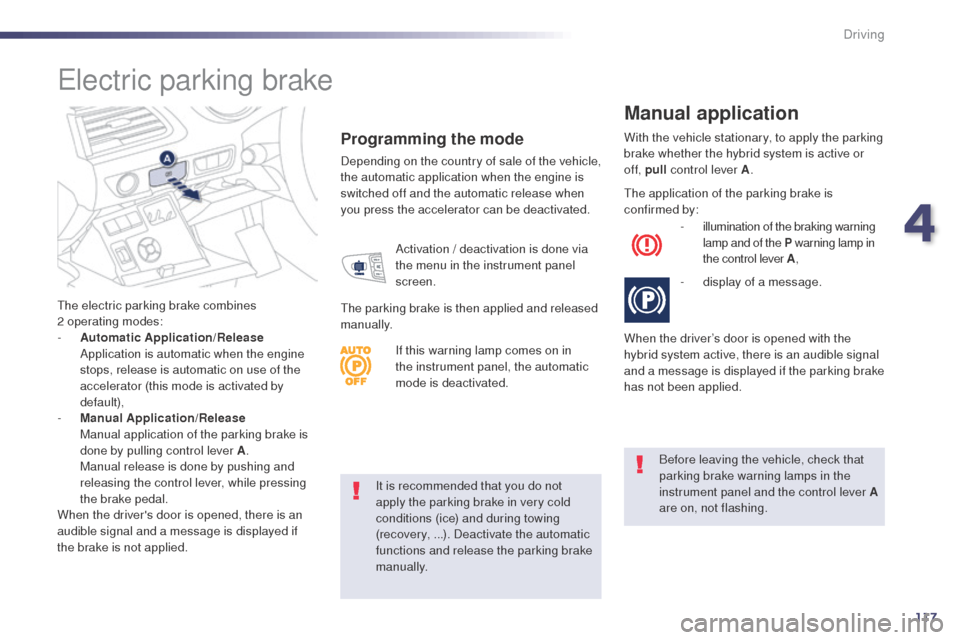
117
508RXH_en_Chap04_conduite_ed01-2014
It is recommended that you do not
apply the parking brake in very cold
conditions (ice) and during towing
(recovery, ...). Deactivate the automatic
functions and release the parking brake
manually. Before leaving the vehicle, check that
parking brake warning lamps in the
instrument panel and the control lever A
are on, not flashing.
th
e electric parking brake combines
2 operating modes:
-
A
utomatic Application/Release
A
pplication is automatic when the engine
stops, release is automatic on use of the
accelerator (this mode is activated by
default),
-
M
anual Application/Release
M
anual application of the parking brake is
done by pulling control lever A .
Ma
nual release is done by pushing and
releasing the control lever, while pressing
the brake pedal.
When the driver's door is opened, there is an
audible signal and a message is displayed if
the brake is not applied.
Programming the mode
Depending on the country of sale of the vehicle,
the automatic application when the engine is
switched off and the automatic release when
you press the accelerator can be deactivated. With the vehicle stationary, to apply the parking
brake whether the hybrid system is active or
of f, pull
control lever A .
Manual application
Activation / deactivation is done via
the menu in the instrument panel
screen.
th
e parking brake is then applied and released
manually.
th
e application of the parking brake is
confirmed by:
-
i
llumination of the braking warning
lamp and of the P warning lamp in
the control lever A ,
-
d
isplay of a message.
When the driver’s door is opened with the
hybrid system active, there is an audible signal
and a message is displayed if the parking brake
has not been applied.
electric parking brake
If this warning lamp comes on in
the instrument panel, the automatic
mode is deactivated.
4
Driving
Page 121 of 338
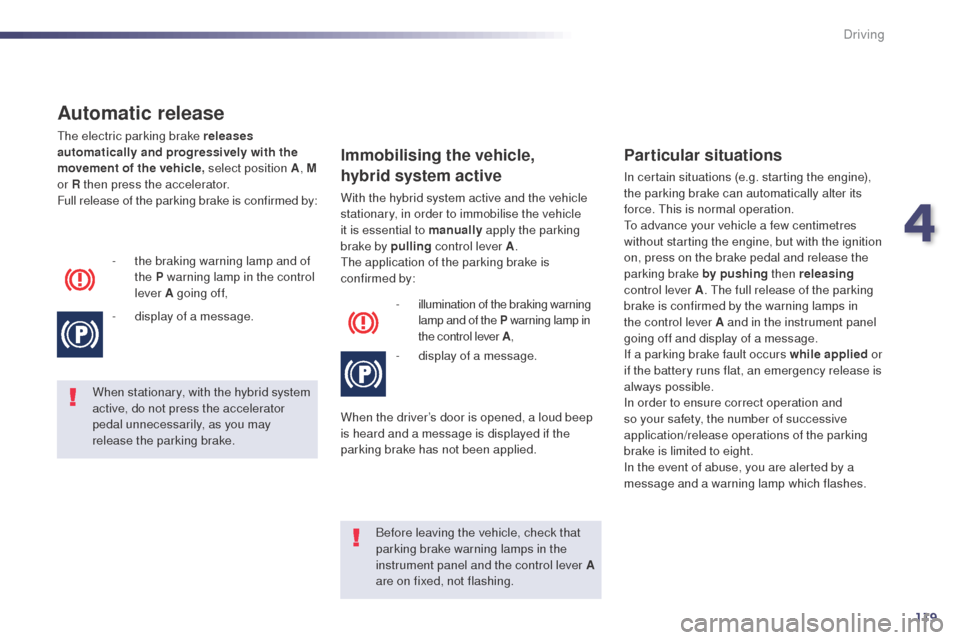
119
508RXH_en_Chap04_conduite_ed01-2014
Automatic release
the electric parking brake releases
automatically and progressively with the
movement of the vehicle, select position A, M
or R then press the accelerator.
Full release of the parking brake is confirmed by:
-
t
he braking warning lamp and of
the P warning lamp in the control
lever A going of f,
-
d
isplay of a message.
When stationary, with the hybrid system
active, do not press the accelerator
pedal unnecessarily, as you may
release the parking brake.
Before leaving the vehicle, check that
parking brake warning lamps in the
instrument panel and the control lever A
are on fixed, not flashing.
Immobilising the vehicle,
hybrid system active
With the hybrid system active and the vehicle
stationary, in order to immobilise the vehicle
it is essential to manually apply the parking
brake by pulling control lever A.
th
e application of the parking brake is
confirmed by:
-
i
llumination of the braking warning
lamp and of the P warning lamp in
the control lever A ,
-
d
isplay of a message.
When the driver’s door is opened, a loud beep
is heard and a message is displayed if the
parking brake has not been applied.
Particular situations
In certain situations (e.g. starting the engine),
the parking brake can automatically alter its
force. t
h
is is normal operation.
to a
dvance your vehicle a few centimetres
without starting the engine, but with the ignition
on, press on the brake pedal and release the
parking brake by pushing then releasing
control lever A .
t
h
e full release of the parking
brake is confirmed by the warning lamps in
the control lever A and in the instrument panel
going off and display of a message.
If a parking brake fault occurs while applied or
if the battery runs flat, an emergency release is
always possible.
In order to ensure correct operation and
so your safety, the number of successive
application/release operations of the parking
brake is limited to eight.
In the event of abuse, you are alerted by a
message and a warning lamp which flashes.
4
Driving
Page 122 of 338
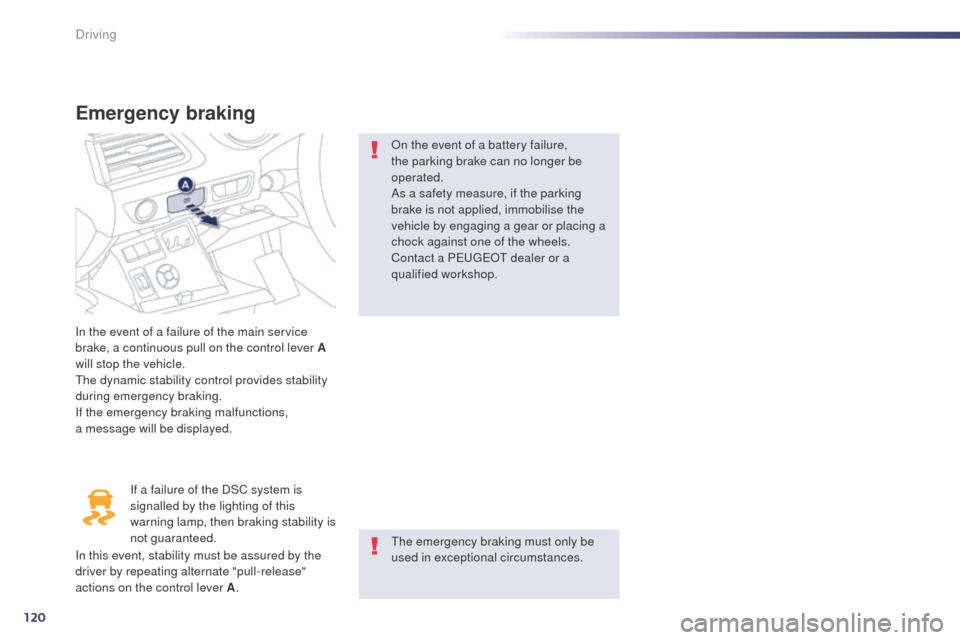
120
508RXH_en_Chap04_conduite_ed01-2014
Emergency braking
In the event of a failure of the main service
brake, a continuous pull on the control lever A
will stop the vehicle.
th
e dynamic stability control provides stability
during emergency braking.
If the emergency braking malfunctions,
a
message will be displayed. If a failure of the DSC system is
signalled by the lighting of this
warning lamp, then braking stability is
not guaranteed.
th
e emergency braking must only be
used in exceptional circumstances.
In this event, stability must be assured by the
driver by repeating alternate "pull-release"
actions on the control lever A
.On the event of a battery failure,
the parking brake can no longer be
operated.
As a safety measure, if the parking
brake is not applied, immobilise the
vehicle by engaging a gear or placing a
chock against one of the wheels.
Contact a P
e
uge
Ot
dealer or a
qualified workshop.
Driving
Page 123 of 338
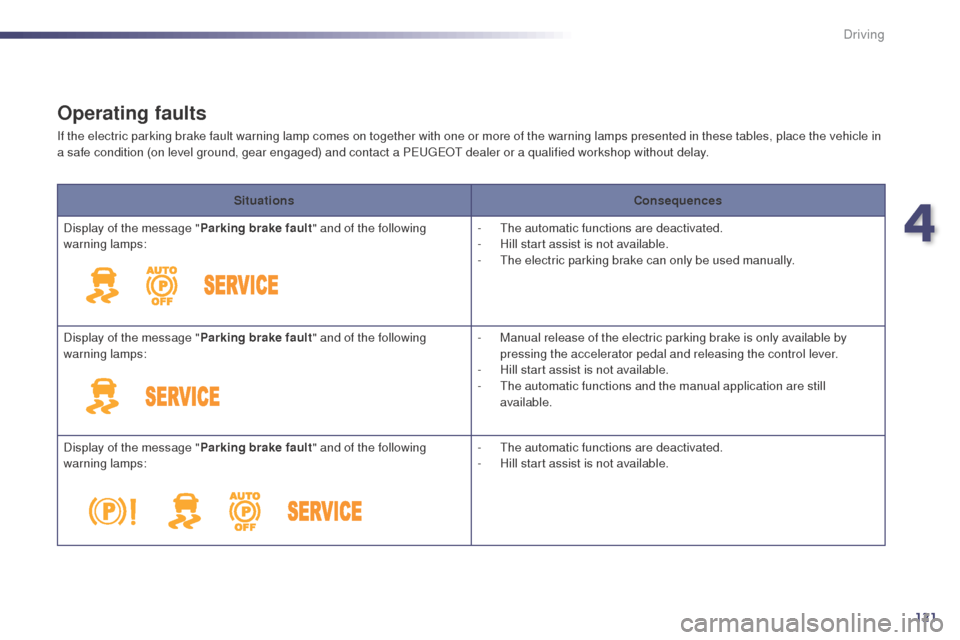
121
508RXH_en_Chap04_conduite_ed01-2014
Operating faults
If the electric parking brake fault warning lamp comes on together with one or more of the warning lamps presented in these tables, place the vehicle in
a safe condition (on level ground, gear engaged) and contact a PeugeOt dealer or a qualified workshop without delay.
Situations Consequences
Display of the message " Parking brake fault" and of the following
warning lamps: -
t
h
e automatic functions are deactivated.
-
H
ill start assist is not available.
-
t
h
e electric parking brake can only be used manually.
Display of the message " Parking brake fault" and of the following
warning lamps: -
M
anual release of the electric parking brake is only available by
pressing the accelerator pedal and releasing the control lever.
-
H
ill start assist is not available.
-
t
h
e automatic functions and the manual application are still
available.
Display of the message " Parking brake fault" and of the following
warning lamps: -
t
h
e automatic functions are deactivated.
-
H
ill start assist is not available.
4
Driving
Page 124 of 338
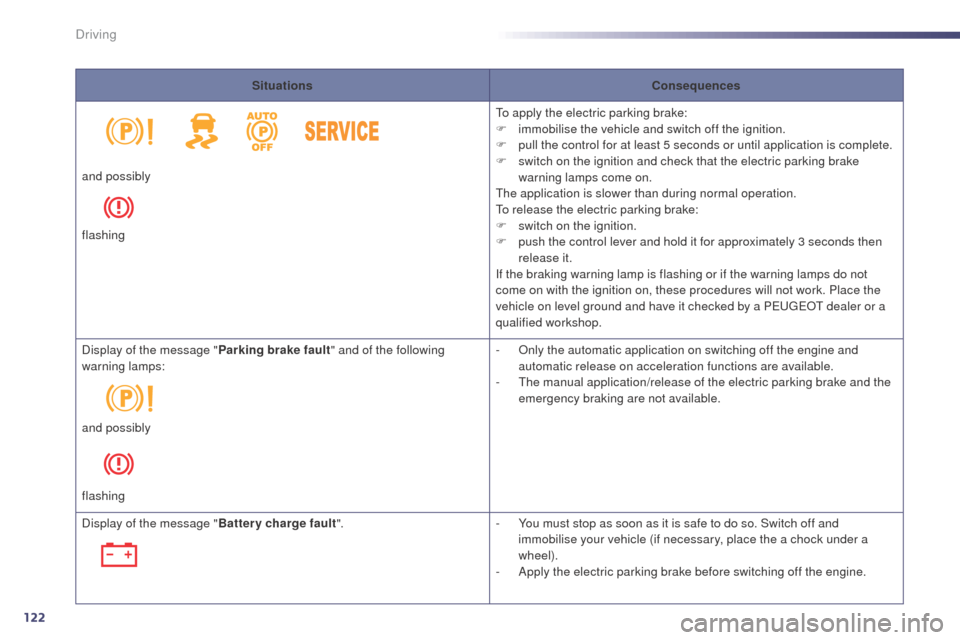
122
508RXH_en_Chap04_conduite_ed01-2014
SituationsConsequences
to a
pply the electric parking brake:
F
i
mmobilise the vehicle and switch off the ignition.
F
p
ull the control for at least 5 seconds or until application is complete.
F
s
witch on the ignition and check that the electric parking brake
warning lamps come on.
th
e application is slower than during normal operation.
to r
elease the electric parking brake:
F
s
witch on the ignition.
F
p
ush the control lever and hold it for approximately 3 seconds then
release it.
If the braking warning lamp is flashing or if the warning lamps do not
come on with the ignition on, these procedures will not work. Place the
vehicle on level ground and have it checked by a P
e
uge
Ot
dealer or a
qualified workshop.
and possibly
flashing
Display of the message "
Parking brake fault" and of the following
warning lamps: -
O
nly the automatic application on switching off the engine and
automatic release on acceleration functions are available.
-
t
h
e manual application/release of the electric parking brake and the
emergency braking are not available.
and possibly
flashing
Display of the message " Battery charge fault". -
Y
ou must stop as soon as it is safe to do so. Switch off and
immobilise your vehicle (if necessary, place the a chock under a
wheel).
-
A
pply the electric parking brake before switching off the engine.
Driving
Page 127 of 338
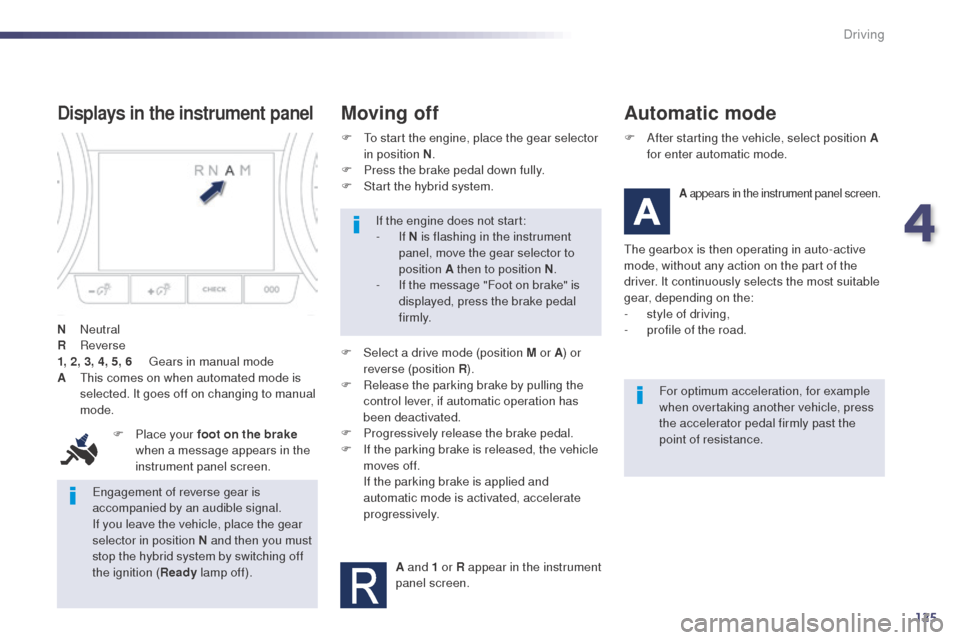
125
508RXH_en_Chap04_conduite_ed01-2014
engagement of reverse gear is
accompanied by an audible signal.
If you leave the vehicle, place the gear
selector in position N and then you must
stop the hybrid system by switching off
the ignition ( Ready lamp off). If the engine does not start:
-
If
N is flashing in the instrument
panel, move the gear selector to
position A then to position N .
-
I
f the message "Foot on brake" is
displayed, press the brake pedal
f i r m l y.
For optimum acceleration, for example
when overtaking another vehicle, press
the accelerator pedal firmly past the
point of resistance.
Displays in the instrument panel
N Neutral
R Reverse
1, 2, 3, 4, 5, 6
g
e
ars in manual mode
A
t
h
is comes on when automated mode is
selected. It goes off on changing to manual
mode.
F
P
lace your foot on the brake
when a message appears in the
instrument panel screen.
Moving off
F Select a drive mode (position M or A ) or
reverse (position R ).
F
R
elease the parking brake by pulling the
control lever, if automatic operation has
been deactivated.
F
P
rogressively release the brake pedal.
F
I
f the parking brake is released, the vehicle
moves off.
I
f the parking brake is applied and
automatic mode is activated, accelerate
progressively.
A and 1 or R appear in the instrument
panel screen.
Automatic mode
A appears in the instrument panel screen.
the gearbox is then operating in auto-active
mode, without any action on the part of the
driver. It continuously selects the most suitable
gear, depending on the:
-
s
tyle of driving,
-
p
rofile of the road.
F
t
o s
tart the engine, place the gear selector
in position N .
F
P
ress the brake pedal down fully.
F
S
tart the hybrid system.
F
A
fter starting the vehicle, select position A
for enter automatic mode.
4
Driving
Page 128 of 338
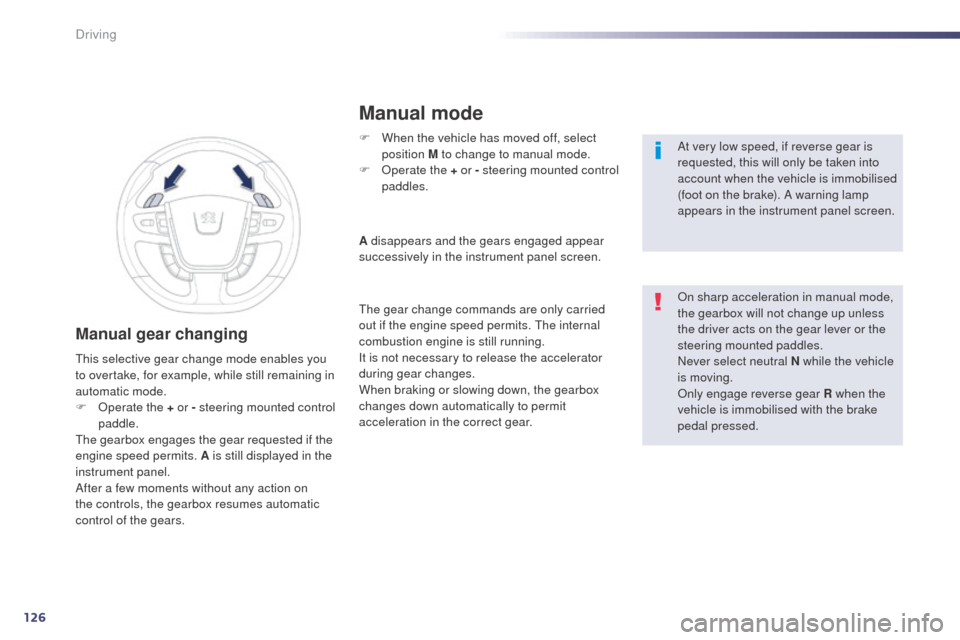
126
508RXH_en_Chap04_conduite_ed01-2014
Manual gear changing
F When the vehicle has moved off, select position M to change to manual mode.
F
O
perate the + or - steering mounted control
paddles. At very low speed, if reverse gear is
requested, this will only be taken into
account when the vehicle is immobilised
(foot on the brake). A warning lamp
appears in the instrument panel screen.
On sharp acceleration in manual mode,
the gearbox will not change up unless
the driver acts on the gear lever or the
steering mounted paddles.
Never select neutral N while the vehicle
is moving.
Only engage reverse gear R when the
vehicle is immobilised with the brake
pedal pressed.
A disappears and the gears engaged appear
successively in the instrument panel screen.
th
e gear change commands are only carried
out if the engine speed permits.
t
h
e internal
combustion engine is still running.
It is not necessary to release the accelerator
during gear changes.
When braking or slowing down, the gearbox
changes down automatically to permit
acceleration in the correct gear.
th
is selective gear change mode enables you
to overtake, for example, while still remaining in
automatic mode.
F
O
perate the + or - steering mounted control
paddle.
th
e gearbox engages the gear requested if the
engine speed permits. A is still displayed in the
instrument panel.
After a few moments without any action on
the controls, the gearbox resumes automatic
control of the gears.
Manual mode
Driving
Page 131 of 338
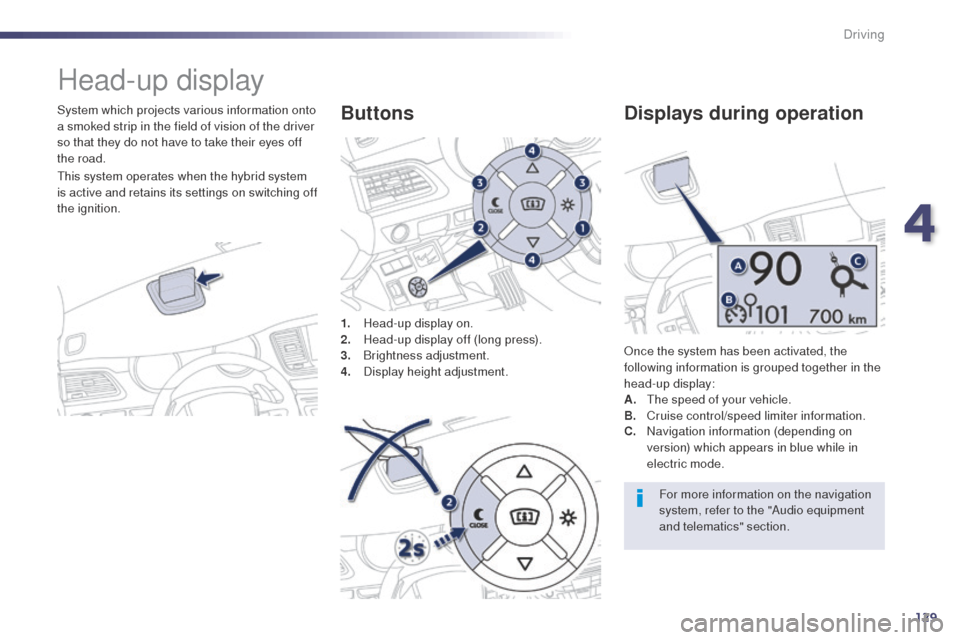
129
508RXH_en_Chap04_conduite_ed01-2014
Head-up display
System which projects various information onto
a smoked strip in the field of vision of the driver
so that they do not have to take their eyes off
the road.1.
H
ead-up display on.
2.
H
ead-up display off (long press).
3.
Br
ightness adjustment.
4.
D
isplay height adjustment.Buttons
Once the system has been activated, the
following information is grouped together in the
head-up display:
A.
t
h
e speed of your vehicle.
B.
C
ruise control/speed limiter information.
Displays during operation
C. Navigation information (depending on version) which appears in blue while in
electric mode.
For more information on the navigation
system, refer to the "Audio equipment
and telematics" section.
th
is system operates when the hybrid system
is active and retains its settings on switching off
the ignition.
4
Driving